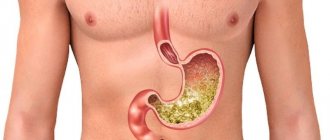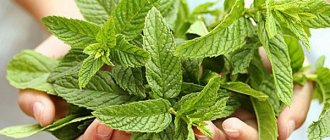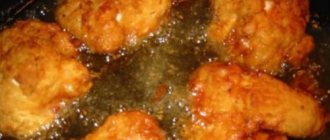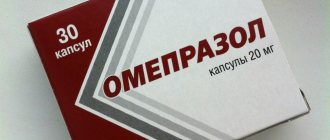Description
Increased gastric acidity is a condition in which there is a shift in the pH of gastric juice or contents to the strongly acidic side. In addition, signs of hyperacidity can be caused by gastric contents entering the lower esophagus.
In most clinical cases, increased acidity occurs due to the fact that the cycle of gastric juice production is disrupted. Such processes can occur against the background of high levels of the hormone pepsin, which is responsible for stimulating the glandular cells of the organ, or hyperplasia of the mucous membrane. It is extremely important to reduce the acidity in the stomach, as this is fraught with the development of more severe pathological conditions.
Sometimes, acidity in the stomach increases due to dietary errors. Eating excess amounts of some foods can change the acid level, which is due to the presence in them of a large amount of their own acids or substances that stimulate secretion. Such products include:
- Sour vegetables or fruits. The most common food products of plant origin are tomatoes, cabbage, and citrus fruits. Most vegetables and fruits contain organic acids.
- Hot and spicy food. Almost all seasonings have an irritating effect on the mucous membrane, which leads to increased production of hydrochloric acid.
- Carbonated and alcoholic drinks. Carbon dioxide, which is contained in carbonated drinks, can form carbon dioxide when it enters the stomach cavity. In addition, when carbon dioxide is combined with ethyl alcohol, the situation gets worse. This is due to the fact that its low concentration stimulates digestion, as well as the secretion of digestive juices.
When changes occur due to the consumption of certain foods or drinks, the symptoms are temporary and do not tend to recur.
There are individual clinical cases when the acid concentration increases due to physiological changes in the body’s functioning. Such processes occur during adolescence, as well as during pregnancy.
This is due to the fact that hormones regulate the activity of all organ systems of the human body without exception. Changes in hormonal levels can cause a hyperacid state, or cause a lack of gastric juice.
During puberty, there is a hormonal imbalance in both girls and boys. This condition is not considered a disorder if its manifestations disappear after normalization of hormone levels.
During pregnancy, symptoms of increased stomach acidity appear not only due to hormonal changes, but also due to mechanical irritation of the walls of the digestive tract by the growing fetus.
Milk thistle
What other herbs reduce stomach acidity? Milk thistle is the most effective remedy for restoring damaged stomach walls. It helps get rid of almost all the symptoms of hyperacid gastritis: relieves nausea, pain, heartburn and bad breath. In collaboration with other plants, it can suppress inflammation and restore imbalance in the digestive system. Don’t forget about the ability to prevent complications. People who are treated with milk thistle do not need to worry about the appearance of ulcers.
Diseases
In most cases, especially in the adult population, an increase in acidity occurs against the background of the development of pathology of the digestive system. Most often, such a change is observed in various diseases of the stomach and duodenum, but can also occur in diseases of the liver, pancreas or lower intestine.
How to treat high stomach acidity depends solely on what led to the appearance of this condition.
Gastritis
The main pathology in which an increase in acid concentration can occur is hyperacid gastritis. This disease is inflammatory in nature, against which hyperplastic areas of the mucous membrane appear.
The mucous membrane contains a large number of glandular cells and mechanoreceptors that respond to food intake. An increase in the number of these structural units leads to the fact that food entering the lumen of the stomach causes the production of an excess amount of hydrochloric acid necessary for digestion.
Unspent acid irritates the walls of this hollow organ, causing new inflammation, which causes further progression of the disease.
Interesting! What is the significance of hydrochloric acid in the composition of gastric juice?
It is worth noting the fact that over time, the hyperacid state is replaced by a decrease in acidity, that is, there is a lack of gastric juice, as the mucous membrane is destroyed. It is better to take medications for hyperacidity in this disease as prescribed by a doctor.
Gastritis can be either acute or chronic. It is worth noting that acute gastritis is rarely accompanied by increased acidity.
Peptic ulcer
Peptic ulcer is a destructive disease of the stomach and duodenum, which is accompanied by the appearance of a peptic ulcer. The formation of an ulcer leads to the disruption of the contractility of these organs, as damage to the muscle layer is observed.
In addition, the penetration of hydrochloric acid into the muscle layer leads to irritation of nerve endings, which can stimulate secretory function and spasm of the organ. In case of peptic ulcer, the greatest danger is localization in the area of the duodenal bulb. This is due to the fact that an ulcer in this area leads to disruption of the pyloric sphincter.
Due to such disorders, food cannot pass normally into the duodenum from the stomach, and therefore stagnates there. Leaving food in the stomach for a long time leads to the production of excess hydrochloric acid, which increases acidity.
Duodenitis
Gastritis and duodenitis extremely rarely occur separately. Inflammation of the duodenum can be both the initial cause and the result of gastritis. Inflammation of the duodenum prevents the normal movement of digested food, which can change the acidity level in the stomach.
Diseases of the gallbladder and pancreas
Various inflammatory diseases of the biliary tract and pancreas are closely related to the stomach and duodenum, since they have a direct anatomical connection. Cholecystitis and pancreatic juice play a vital role in neutralizing hydrochloric acid. It is these digestive juices that neutralize excess hydrochloric acid to prevent injury to the small intestine.
Such diseases most often develop against the background of poor nutrition, when there is an excess of fatty, fried, smoked foods. These pathologies are often chronic in nature, since it is extremely difficult to restore the normal function of these organs.
You should not listen to how neighbors or acquaintances lower stomach acidity at home, since the presence of the disease requires full treatment.
Folk recipes
Very closely related to dietary recommendations is the method of reducing stomach acidity using folk remedies. It should immediately be noted that the widely known method - baking soda, although it neutralizes the acidic environment quickly, but does this with the release of gas and the formation of sediment.
The concentration of active substances in the herbal ingredients of natural recipes is low. But with their help you can reduce the acidity of stomach juice quite quickly. Therefore, they must be treated with the same attention as pharmaceutical products. And use them only after consultation or on the recommendation of your doctor.
- Beekeeping products . Honey can be taken for the prevention of diseases of the gastrointestinal tract (and not only) in the form of a solution of 1 tbsp. spoons in 200 ml of clean water, drinking on an empty stomach every morning. For the treatment of hyperacid conditions, a proportion of 1 tsp is recommended. per 100 ml of water, 3 times a day for a month, 30 minutes before main meals. Using 1 tsp helps fight acidification even more effectively. a mixture of honey with natural aloe juice in equal parts, in the same frequency, in the same course.
- Propolis is also highly effective for the purpose of quickly and permanently reducing stomach acidity at home. A tincture is prepared from it by grinding 35 g, pouring alcohol (so that it completely hides the bee glue), infusing for 2 weeks in a dark, cool place; Take for 1 month, once a day - in the morning on an empty stomach 15 minutes before breakfast, adding 15 drops of tincture to a glass of water. A mixture of pureed propolis and butter (50 and 200 g, respectively) is poured with a small amount of boiling water, heated until smooth in a water bath, filtered and poured into a glass container; 1 tsp each 3 times a day (before main meals) for a month (stored in the refrigerator). Bee glue can be chewed in its pure form - the active substances, dissolving in saliva, will also act in the esophagus. This method and oil solution are good to use to remove inflammation during reflux esophagitis.
- Fresh sea buckthorn And the oil from its seeds is very effective in reducing hyperacidity. Can be taken together or alternating with pumpkin oil, in a total volume of 1 tsp. in the morning on an empty stomach. A decoction is made from dry sea buckthorn (1 cup of berries per 1 liter of water) and used instead of water, using honey or propolis tincture. Their combined action has a very beneficial effect on increasing the overall resistance of the body and immunity.
- Decoctions of other plants that can relieve high acidity can be purchased at the pharmacy as a ready-made mixture, or you can make it yourself. The main ones: mint, yarrow herb, celandine, dill, licorice and calamus root, chamomile, plantain, centaury, St. John's wort, caraway. The ratio of ingredients and their proportions are selected individually for each specific patient (according to a clinical examination). Natural remedies should be prescribed only by the attending physician - a gastroenterologist, preferably with the consultation of a herbalist. Their independent use is fraught with aggravation of the condition or the development of allergic reactions.
Symptoms
Clinical manifestations of increased gastric acidity usually differ little, given the reasons for its increase. So, the following are the main symptoms of high stomach acidity:
- Heartburn. A mandatory sign of a change in acid level is heartburn. This clinical manifestation is not critical, but it causes a lot of discomfort. Considering the root cause of its occurrence, heartburn can occur immediately after eating or after some time. The appearance of regular attacks of heartburn is a sign that it is associated with an existing disease, and not with errors in the diet. Under such circumstances, it will be easiest to reduce stomach acidity at home.
- Pain in the left epigastric region. Excessive amounts of hydrochloric acid have a traumatic effect on the walls of the stomach, which leads to pain. How severe the pain is depends on the etiological factor. So, with gastritis, the pain will be moderate, and with a peptic ulcer, it will be significant. Sometimes, pain may require the use of analgesics.
- Dyspeptic disorders. A change in the normal digestive process results in a number of changes in the digestive system, such as diarrhea, nausea or vomiting. The latter may appear regardless of food intake. This is due to the fact that due to the inflammatory process, the stomach receptors are constantly irritated, perceiving an empty stomach as full. The appearance of such symptoms can also occur during the use of drugs that reduce gastric acidity, due to their side effects.
- Deterioration in general health. If the hyperacid state is caused by a disease, then a general reaction of the body may occur, in the form of an increase in body temperature to low-grade levels, decreased appetite, and general malaise.
Interesting! Concept and indications for use of natural gastric juice
Before choosing a way to get rid of high stomach acidity, you need to consult a doctor to determine the cause of this condition.
Symptoms of high stomach acidity
Almost the only, most noticeable and at the same time least pleasant symptom is heartburn. In principle, if the patient’s acidity has increased for some reason or even was this way from birth, without special therapeutic measures it will remain so. It should be noted that congenital abnormalities account for the majority of such cases.
If it is naturally high, attacks of heartburn are usually associated, strange as it may sound, with the phases of the moon. But, besides this, it can “jump up” due to a number of other factors. Many gastroenterologists are confident that a considerable part of cases of acquired high acidity in patients is associated with stress. And in such cases, a new round of symptoms triggers another unpleasant conversation with the boss, and the moon has nothing to do with it.
One way or another, during the period of exacerbation, patients experience the following symptoms:
- Heartburn is the rise of some acid from the stomach up the esophagus. It leads to a sore throat and often burns the mucous membranes of the esophagus;
- If high acidity has caused complications in the form of inflammation/erosion of its walls or (which is much more likely) the walls of the duodenum, the attack is accompanied by more or less pronounced symptoms of aching pain in the upper abdomen, closer to the rib line.
Survey
Diagnostic measures, when complaints of heartburn or pain near the epigastric region are expressed, begin with a medical examination and medical history. If the hyperacid state is associated with dietary errors, then in such a situation the stomach will be completely painless, and the anamnesis will contain information about the consumption of typical foods.
If any pathology of the digestive system is suspected, the patient must undergo the following examinations to make a diagnosis and select effective treatment:
- General clinical laboratory tests. Any disease in the human body is reflected in the result of a general blood test. In addition, pathologies of the biliary tract and pancreas are accompanied by characteristic changes in biochemical analysis. Such examinations are indicated for all patients without exception.
- FGDS. Fibrogastroduodenoscopy is the most informative method for examining the upper parts of the digestive system. This examination may reveal areas of inflammation, ulcers, neoplasms or structural changes. The advantage of this method is that during the insertion of the endoscope, the acidity of gastric juice can be measured.
- Fractional sensing. Those patients in whom a suspicion of pathology of the liver, biliary or pancreas has been made, it is necessary to undergo fractional sounding, which evaluates the secretory ability of these organs.
A properly constructed diagnostic plan helps determine how to get rid of unpleasant manifestations forever.
Main symptoms
Gastritis with high acidity has the following symptoms:
- Various types of pain in the abdominal area (sharp, cutting, stabbing, dull, long-lasting/for a couple of minutes, etc.). It can appear before or after meals.
- Frequent occurrence of heartburn. The patient feels a strong burning sensation in the area of the esophagus.
- Specific belching with a sour taste. As a rule, in parallel there is an unpleasant rotten odor from the mouth.
- A yellowish coating may form on the surface of the tongue and palate.
- Heaviness in the stomach, constant nausea and periodic bloating.
- Problems with stool appear. Some patients begin to suffer from constipation, others complain of diarrhea.
- Lost appetite.
All of the above symptoms greatly affect the general condition of the body. The person becomes lethargic or, conversely, irritable. He sleeps poorly and gets tired quickly even from light exercise.
Treatment
Treatment of high stomach acidity has several directions, the combination of which is determined for each patient individually. Highlight:
- Diet correction.
- Antacids.
- Proton pump inhibitors.
- Prokinetics.
- Aids and recommendations.
For those patients whose problem is caused by the consumption of certain foods, there is no need to take tablets for high stomach acidity. It will be enough for them to balance their diet and adhere to some restrictions. To improve your well-being, you can take folk remedies that reduce the acidity of gastric juice.
Diet
In order to prevent the appearance of unpleasant symptoms due to increased stomach acidity, for many people it is enough to eliminate or significantly limit a number of foods and drinks. Among them are:
- Fresh vegetables and fruits.
- Pickles.
- Spices.
- Smoked and fried foods.
- Sour juices and fruit drinks.
- Fermented milk products.
- Alcohol.
- Carbonated drinks.
Following these recommendations allows you to restore the normal digestion process and eliminate the amount of free acid. Even in the early stages of gastritis, the disease can be completely eliminated without the use of medications.
It is worth noting the fact that with the help of some folk remedies you can effectively reduce acidity, while they are completely safe. One such remedy is milk. It has an alkaline environment, which quickly neutralizes excess acid.
There is no better way to reduce stomach acidity at home than drinking baking soda. Sodium bicarbonate powder is present in every housewife's kitchen. It can be taken orally as an aqueous solution or a dry substance.
It is worth remembering that this product is suitable only for rare uses. Its long-term use may have consequences associated with trauma to the mucous membrane by chemical reaction products.
In addition, it is worth remembering that it is important to eat on a schedule, since the body begins to produce gastric juice even before a person begins to eat. Eating meals at the same time will allow you to use gastric juice with maximum benefit for digesting food.
Antacids
The most common medications that reduce stomach acidity are antacids. These medications contain substances that react chemically with hydrochloric acid, neutralizing it.
Interesting! What symptoms indicate zero stomach acidity?
Today, there are two groups of antacids - absorbable and non-absorbable. The difference between them is that those absorbed during a chemical reaction form compounds that can enter the bloodstream, causing a general reaction in the body.
But non-absorbable ones do not have such an effect, which makes it possible to reduce the number of contraindications and side effects to a minimum. Such drugs to reduce stomach acidity are widely used today in gastroenterology.
In addition, the difference between these groups is that they have different rates of onset of the therapeutic effect and the time it lasts. Absorbable drugs can quickly reduce the amount of acid, but this effect is extremely short-lived.
Non-absorbable ones take longer to act, but a decrease in stomach acidity occurs after 15-30 minutes. Accordingly, a person needs to wait until his condition returns to normal.
The most common representatives of this pharmacological group are:
- Rennie.
- Gastal.
- Gaviscon.
- Almagel.
- Maalox.
All non-absorbable drugs that reduce gastric acidity are allowed to be taken even during pregnancy or breastfeeding, as well as for children over 6 years of age. These drugs cause side effects exclusively from the digestive tract. Most often, they affect the stool.
When taking such a medicine for high stomach acidity, a person should understand that it only eliminates the symptoms. To fully treat the disease, you will need to take other medications.
Proton pump inhibitors
These drugs can eliminate the causes of increased stomach acidity - hyperactivity of the glands. They inhibit their secretory function, thereby reducing the amount of hydrochloric acid released.
If antacids can be taken on their own for a short period of time, then these substances are best used after a doctor’s prescription, as they have a number of contraindications and serious side effects.
The main representatives of pump pump inhibitors are:
- Omeprazole.
- Esomeprazole.
- Pantoprazole.
They can be produced under various trade names, and also contain auxiliary agents aimed at eliminating the cause of peptic ulcer disease - Helicobacter Pylori. But, despite this, the effect of taking them will be unchanged.
Prokinetics
Most often, the discomfort caused by a hyperacid state is associated with irritation of the lower part of the esophagus. In order to normalize the movement of food through the digestive system, it is necessary to use prokinetics.
These medications will not help normalize the acid level of gastric juice, but will prevent the backflow of contents with an aggressive environment into the esophagus.
The most famous representative of this group of drugs is Motillium. It normalizes muscle contractions of the walls of the intestines and stomach, which completely eliminates the risk of food moving back.
Folk remedies
There are many folk remedies for normalizing the pH of the gastric environment. How to reduce stomach acidity using folk remedies should be learned from relevant specialists. You need to consult a herbalist or traditional medicine doctor.
Independent use of traditional methods can have the same consequences for a person as taking medications.
Some folk remedies for high stomach acidity are of plant or organic origin. That is, they can cause allergic reactions. It is this feature that requires mandatory consultation with a doctor.
Despite the fact that each person is responsible for his own health, a medical specialist should be involved in eliminating signs of increased stomach acidity. Self-medication is not recommended, since the symptoms can be eliminated, but the problem will remain, which can even cause cancerous tumors.
Acid-reducing drugs for patients with gastritis
Proton pump inhibitors
This group includes drugs whose mechanism of action is based on inhibition of the processes of HCl production by the glands of the fundus of the stomach. Their effect is due to blocking the work of the proton pump - a cellular pump that transports sodium, hydrogen and chlorine ions.
| Generation IPP | Commercial names | How to use | Contraindications | Price |
| 1 - omeprazole | "Omez", "Losek" | in the morning on an empty stomach, 1 capsule (20 mg), without chewing | intolerance, pregnancy, age up to 12 years, lactation | 40-350 rub. |
| 2 - lansoprazole | "Lanzabel", "Lanzap", "Lantsid" | in the morning 15-30 mg on an empty stomach | intolerance, 1st trimester of pregnancy, gastrointestinal tumors, age up to 18 years | 100-200 rub. |
| 3 - pantoprazole | "Nolpaza" | 20 mg per day in the morning | childhood, pregnancy, chronic renal failure (CRF), breastfeeding | 150-500 rub. |
| 4 - rabeprazole | "Rabezol", "Pariet" | 10 or 20 mg per day in the morning | gastrointestinal tract tumors, childhood, pregnancy, lactation period | 100-350 rub. |
After taking a PPI orally, the level of hydrochloric acid decreases during the first hour, the effect of the drug lasts on average 24 hours, which requires a single dose. In case of hyperacid condition, reflux disease, it is necessary to take tablets for 2-4 weeks, which depends on the severity of the disease. To suspect that you have a disorder of acid-forming function, you need to know the symptoms of increased stomach acidity.
Histamine receptor blockers
Medicines in this group directly inhibit H2-histamine receptors, which helps reduce gastric secretion and suppresses pain.
List of medications that lower pH levels:
| Generation | Comm. titles | How to use | Contraindications | Price |
| 1-cimetidine | "Primamet", "Histodil" | orally 800 mg before meals 400 mg 2 times a day | pregnancy, chronic renal failure, chronic heart failure (CHF), age under 16 years, hypersensitivity | 2000-2400 rub. |
| 2-ranitidine | "Rantak", "Zantac", "Gistak" | 150 mg twice daily before meals | pregnancy, age up to 12 years, chronic renal failure, cirrhosis, lactation, porphyria | 100-300 rub. |
| 3 - famotidine, nizatidine, roxatidine | "Kvamatel", "Ulfamid", "Roxan", "Axid" | 20 mg once or twice a day | lactation period, age up to 3 years, pregnancy, intolerance | 100-1000 rub. |
Hyperacidity, chronic gastritis and peptic ulcers can be cured with 2nd and 3rd generation H2 blockers. The highest bioavailability was recorded for Roxatidine, which reduces the concentration of hydrochloric acid for approximately 14-16 hours.
Roxatidine and Nizatidine rarely have side effects; Cimetidine is characterized by adverse reactions in 3.3% of cases.
The optimal course of treatment should last at least 2 weeks. It is important to take the pills at the same time every day. According to general recommendations, H2-histamine receptors are contraindicated in people with individual intolerance to their components, renal or heart failure. They are also not recommended for use by persons under 16 years of age, nursing mothers and women during pregnancy. You can find out what medications are allowed in the article on how high acidity is treated during pregnancy.
M-anticholinergics (anticholinergics)
All drugs in this group suppress the secretion of hydrochloric acid and reduce the tone of the smooth muscles of the stomach and other organs of the digestive system.
| Non-selective M-CB | Selective M-HB | |
| Titles | "Atropine", "Platifillin" | "Pirenzepine" |
| Mechanism of action | disrupt the transmission of nerve impulses, increase parasympathetic innervation to the stomach | by blocking M1-cholinergic receptors, they inhibit acid production and have an antiulcer effect |
| How to drink | 1 tablet three times a day | The dosage regimen is determined by the doctor |
| Contraindications | glaucoma, coronary heart disease (CHD), toxic goiter, liver failure | individual intolerance |
| Price | 60-100 rub. | 250-500 rub. |
Non-selective blockers have a short-term antisecretory effect and have extremely limited indications (during exacerbation of peptic ulcer disease, as well as in combination with antacids). Selective anticholinergics quickly inhibit the secretion of HCl and pepsin. They help get rid of heartburn and pain. They have a significant advantage - they practically do not cause adverse reactions and do not penetrate the brain.
Antacids
They quickly but briefly neutralize acid, reduce its irritating effect on the stomach wall, suppress the aggressiveness of proteolytic enzymes and restore the tone of the cardiac sphincter. Equally important, antacids coat the inner lining of the stomach, protecting it. This group of drugs that reduce the aggressive effect of HCl on the stomach is divided into 2 types:
| Subgroup | Commercial names | average price |
| Absorbable antacids | "Rennie", "Vicair", magnesium oxide, calcium carbonate, "Vicalin" | 50-500 rub. |
| Non-absorbable antacids | "Maalox", "Phosphalugel", "Almagel", "Almagel A" | 100-450 rub. |
Absorbed antacids dissolve in the systemic circulation and rapidly reduce acidity. Despite the rapidly developing effect, its effect wears off within a short period of time. With prolonged use, increased blood pressure, swelling, weakness and nausea may occur.
One of the most notable adverse reactions of these drugs is the so-called acid rebound. The carbon dioxide produced by antacids stretches the stomach and reduces the tone of the lower esophageal sphincter. As a result, this leads to increased secretion of hydrochloric acid.
The non-absorbable group does not enter the blood at all, therefore it is safer. The drugs adsorb acid ions onto themselves, envelop the mucous membrane, and bind bile acids.
Phosphalugel, Almagel are taken 1.5 hours before meals 3-4 times a day. The therapeutic course should last 2-3 weeks.
Due to the fact that antacids neutralize HCl for a short time, they are recommended to be combined with proton pump inhibitors or histamine receptor blockers. In some cases, you can reduce stomach acidity with folk remedies.
Alginates
Most often used for heartburn, hyperacid gastritis in combination with other medications. They bind with HCl to form alginic acid; adsorb toxins, promote healing of erosions and ulcers; inhibit bacterial activity.
Advantages of the alginate group:
- rapid onset of action;
- enveloping the mucous membrane;
- antireflux effect;
- acid neutralizing ability;
- rare development of side effects.
Medicines of this group (Gaviscon, Laminal) are contraindicated during breastfeeding, in case of individual intolerance, children under 6 years of age, and pregnant women. Gaviscon is taken 20-80 ml per day in three or four doses after meals and before bed.










